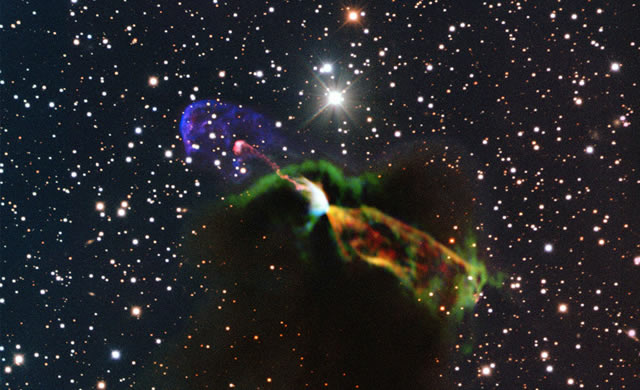
Alcuni astronomi usando ALMA (Atacama Large Millimeter/submillimeter Array) hanno ottenuto una vivida immagine da vicino del materiale che fluisce da una stella appena nata. Osservando la luminescenza prodotta dalle molecole di monossido di carbonio in un oggetto noto come Herbig-Haro 46/47 hanno scoperto che i getti da questo prodotti sono ancora più energetici di quanto si pensasse finora. Le nuove immagini, molto dettagliate, hanno svelato anche un getto sconosciuto che punta in una direzione completamente diversa.
Le giovani stelle sono oggetti violenti che espellono materiale a velocità elevate, fino a un milione di chilometri all’ora. Quando questo materiale si scontra con il gas circostante si illumina, formando così un oggetto Herbig-Haro. Un esempio spettacolare di questa classe è Herbig-Haro 46/47, a circa 1400 anni luce dalla Terra nella costellazione della Vela, oggetto di studio con ALMA durante la fase di “Early Science”, quando il telescopio era ancora in costruzione e la schiera di antenne ben lontana dall’essere completata. Le nuove immagini rivelano fini dettagli nei due getti, uno che punta verso la Terra e l’altro che si allontana. Il getto in allontanamento era quasi invisibile nelle precedenti fotografie ottenute nella banda ottica, a causa dell’oscuramento dovuto alle nubi di polvere che circondano la stella nascente. ALMA ha fornito immagini molto più nitide rispetto ai telescopi precedenti e ha anche permesso agli astronomi di misurare la velocità con cui il materiale incandescente si muove nello spazio.
Fonte/Leggi tutto → ESO.org
Astronomers using the Atacama Large Millimeter/submillimeter Array (ALMA) have obtained a vivid close-up view of material streaming away from a newborn star. By looking at the glow coming from carbon monoxide molecules in an object called Herbig-Haro 46/47 they have discovered that its jets are even more energetic than previously thought. The very detailed new images have also revealed a previously unknown jet pointing in a totally different direction.
Young stars are violent objects that eject material at speeds as high as one million kilometres per hour. When this material crashes into the surrounding gas it glows, creating a Herbig-Haro object. A spectacular example is named Herbig-Haro 46/47 and is situated about 1400 light-years from Earth in the southern constellation of Vela (The Sails). This object was the target of a study using ALMA during the Early Science phase, whilst the telescope was still under construction and well before the array was completed. The new images reveal fine detail in two jets, one coming towards Earth and one moving away. The receding jet was almost invisible in earlier pictures made in visible light, due to obscuration by the dust clouds surrounding the new-born star. ALMA has not only provided much sharper images than earlier facilities but also allowed astronomers to measure how fast the glowing material is moving through space.
Source/Continue reading → ESO.org

















